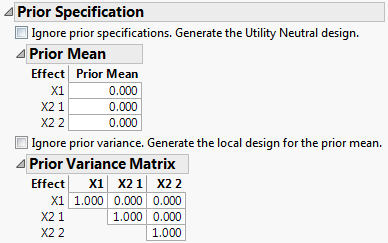Model
In the Choice Design model section, you specify your assumed model and any prior knowledge about the attribute levels. Your assumed mode contains all the effects that you want to estimate. See DOE Model Controls. Specifying prior knowledge about the attribute levels can result in a better design. See Prior Specification.
DOE Model Controls
Specify your assumed model in the DOE Model Controls section. All main effects are included by default. Click the Interactions button to add all two-way interactions.
Figure 19.16 DOE Model Controls
When you construct your design table, JMP saves a Choice script to the data table. The Choice script launches the Choice Platform with the model selected in the DOE Model Controls section.
The DOE Model Controls section contains the following buttons:
Main Effects
Adds main effects for all attributes in the model.
Interactions
Adds all second-order interactions. If you do not want to include all of the interactions, select the interactions that you want to remove and click Remove Term.
Remove Term
Removes selected effects.
Prior Specification
Enter specifications for a multivariate normal prior distribution on the model parameters. Enter the prior distribution’s mean in the Prior Mean section and its covariance matrix in the Prior Variance section.
Figure 19.17 Prior Specification
You can ignore the prior specifications using these options:
Ignore prior specifications. Generate the Utility Neutral design.
Sets the prior means to 0 and generates a locally D-optimal design. This design is called a utility-neutral design. See Huber and Zwerina (1996).
Ignore prior variance. Generate the local design for the prior mean.
Generates a locally D-optimal design. The local design takes into account the prior on the mean but ignores the covariance matrix. See Huber and Zwerina (1996).

